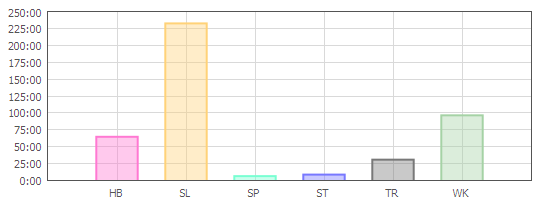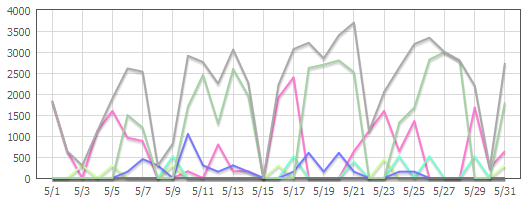Another experience in time management implementation
In due time, I was impressed by a series of topics of habrauser ysichov . In the same place, in the comments, an anonymous author 's article was discovered about the life management system, covering all areas of his life. The article made me think and try to try the technique on myself. About how the article was transformed into, and what was achieved in 2.5 months - this topic.
My opinion - the author - just a monster. To drive all your life into one system is strong. Dividing life into 7 parts, describing each, deriving interconnections, the author gets: a plan for a given period, describing all areas plus a certain quantitative estimate of the lived period. The idea is clear in principle: to describe the plan and assess the quality of the steps taken. Implement it all at once - I'm not ready yet, but I can draw some interesting ideas.
Like the following points:
According to the results of the study of the above materials (in fact, I read the article at least 5 times, so that the necessary moments were put in my head, and thought about my system for at least a week) some abstracts were formed, which formed the basis of my system:
')
Requirements were selected and candidates selected to select the right tool. As a result, each candidate scored a certain number of points as an indicator of fitness. Requirements:
Candidates:
As expected, a worthy candidate was not found to solve such a specific task; therefore, a tool was written whose discussion is beyond the scope of this article. A separate article is dedicated to him.
Every morning I start time management. Open weekly plan and today, project plans. I outline the main tasks for today, check whether there are scheduled meetings (allows you to choose the right clothes) ~ 5 minutes
During the day, I note the used time ~ 15 seconds
In the evening I check whether everything is done, I transfer unfinished business for tomorrow / to the project. Every day is left blank. ~ 1 minute
On Sunday evening or on Monday morning I close the weekly plan (note what has been done) and create a new ~ 10 minutes
On the first of the month I do the same with the monthly plan ~ 15 minutes (along with thoughts)
Below are a few real-life diagrams for the last two months with explanations:

Time flow in May, excluding weights. It turns out (as if I didn’t know it :) sleep is the biggest devourer, and it’s indecently little time to learn (in my case, foreign language) that you need to fix

Spending time on days for June. The week spent on a business trip is clearly visible, when I first worked, watched TV and slept. Not the best time.

This is May again. The time is shown taking into account the weights. It can be seen that productivity and sports have a significant impact on productivity, which is good and correct.
I would like to note the following:
Yes, I began to do more, because I feel the discomfort of the white spots of unfilled time on the daily sheet. That is why I always have a pet project ready, which I do during working hours when I get tired of work (the boss is in the know :)
Yes, I began to do my job on time, as I devote some time to planning. Percentage of accomplishment - approx. 80%
After the weights were chosen for the projects, day and weekly “standards” became clearly visible, for example, the day is 250, the week - 15000. These figures very clearly reflect the degree of my satisfaction with the day / week / month
Ready to answer questions from the audience
What does an anonymous author write about?
My opinion - the author - just a monster. To drive all your life into one system is strong. Dividing life into 7 parts, describing each, deriving interconnections, the author gets: a plan for a given period, describing all areas plus a certain quantitative estimate of the lived period. The idea is clear in principle: to describe the plan and assess the quality of the steps taken. Implement it all at once - I'm not ready yet, but I can draw some interesting ideas.
What would like to apply to yourself?
Like the following points:
- Not just time tracking, like the number of minutes spent at work, but using indexes (or weights) for a more objective assessment.
- Budgeting time for training - for this you can only aspire to
- Simple and visual 2, 3 letter coding of projects and their hierarchies (through "/")
According to the results of the study of the above materials (in fact, I read the article at least 5 times, so that the necessary moments were put in my head, and thought about my system for at least a week) some abstracts were formed, which formed the basis of my system:
Idea:
- Time management to be. First of all, to look at the lived period of life and give it an estimate
- Records are subject (at this stage): work (WK), hobby (HB), training (ST), sports (SP), transport (TR), sleep (SL)
- Time quantum - 15 minutes
- Mandatory weekly and monthly plans agreed with each other. Annual - while in the plans
')
Instruments:
Requirements were selected and candidates selected to select the right tool. As a result, each candidate scored a certain number of points as an indicator of fitness. Requirements:
- Price (for example, the cost of an annual subscription)
- Reliability (the probability that my data will disappear for any reason)
- Willingness (degree of compliance with the tasks)
- Offline (access without internet access)
- Mobility (availability of mobile version)
- Speed / Expandability (how will the service handle the accumulated data for the month / year / 5 years)
- Statistics (reports, charts)
- Timer (built-in time tracking mechanism)
- Planning (the ability to keep notes, make ToDo sheets, etc.)
Candidates:
- Microsoft Excel
- Microsoft Outlook
- Google docs
- OpenOffice.org
- mGSD (who has not heard of this, can see here this article is worth a separate article)
- Paper with pen
As expected, a worthy candidate was not found to solve such a specific task; therefore, a tool was written whose discussion is beyond the scope of this article. A separate article is dedicated to him.
Process and result:
Every morning I start time management. Open weekly plan and today, project plans. I outline the main tasks for today, check whether there are scheduled meetings (allows you to choose the right clothes) ~ 5 minutes
During the day, I note the used time ~ 15 seconds
In the evening I check whether everything is done, I transfer unfinished business for tomorrow / to the project. Every day is left blank. ~ 1 minute
On Sunday evening or on Monday morning I close the weekly plan (note what has been done) and create a new ~ 10 minutes
On the first of the month I do the same with the monthly plan ~ 15 minutes (along with thoughts)
Below are a few real-life diagrams for the last two months with explanations:

Time flow in May, excluding weights. It turns out (as if I didn’t know it :) sleep is the biggest devourer, and it’s indecently little time to learn (in my case, foreign language) that you need to fix

Spending time on days for June. The week spent on a business trip is clearly visible, when I first worked, watched TV and slept. Not the best time.

This is May again. The time is shown taking into account the weights. It can be seen that productivity and sports have a significant impact on productivity, which is good and correct.
Findings:
I would like to note the following:
Yes, I began to do more, because I feel the discomfort of the white spots of unfilled time on the daily sheet. That is why I always have a pet project ready, which I do during working hours when I get tired of work (the boss is in the know :)
Yes, I began to do my job on time, as I devote some time to planning. Percentage of accomplishment - approx. 80%
After the weights were chosen for the projects, day and weekly “standards” became clearly visible, for example, the day is 250, the week - 15000. These figures very clearly reflect the degree of my satisfaction with the day / week / month
Ready to answer questions from the audience
Source: https://habr.com/ru/post/97621/
All Articles